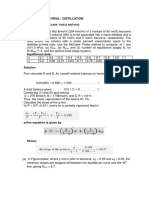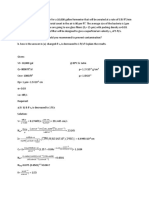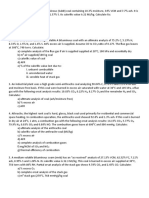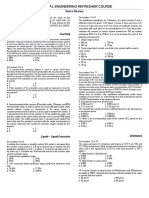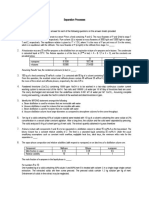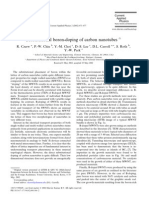Distillation
Distillation
Uploaded by
anita_shar29Copyright:
Available Formats
Distillation
Distillation
Uploaded by
anita_shar29Original Description:
Copyright
Available Formats
Share this document
Did you find this document useful?
Is this content inappropriate?
Copyright:
Available Formats
Distillation
Distillation
Uploaded by
anita_shar29Copyright:
Available Formats
1. A continuous rectification column is used to separate a binary mixture of A and B. Distillate is produced at 100 kgmol/hr containing 98 mole% A.
The mole fraction of A in the liquid and in the vapor, x and y respectively, from two adjacent ideal plates in the enriching section are as follows, x y 0.65 0.82 0.56 0.76 The latent heat of vaporization is the same for all mixtures and if the feed is a saturated liquid, calculate, (i) the reflux ratio and (ii) vapor rate in the stripping section in kgmoles/hr. [(i) R=1.54; (ii) 253.84 kgmoles/hr] 2. A continuous stream of a binary liquid mixture, containing x F mole fraction of A, is fed into a flash distillation unit. Feed is represented by point Q on the enthalpy-concentration diagram as shown in Figure (1). The products out of the unit are a vapor stream ( yV mole fraction of A) and a liquid stream ( x L mole fraction of A). (i) (ii) Obtain an expression for the ratio of vapor flow rate to feed in terms of composition. Show that the distance PQ gives the heat added per mole of Figure (1).
3. The following information is available from the records of binary fractionating column: Feed = 180 kgmole/hr and 60% vaporized Distillate = 100 kgmole/hr with 0.02 mole fraction of the less volatile component Reboiler steam demand = 420 kg/hr Latent heat of column liquid = 3104 J/gmole Latent heat of steam in reboiler = 2200 J/g Calculate, (i) The operating reflux ratio (ii) The composition of vapor entering that plate from which liquid overflow contains 0.7 mole fraction of the more volatile component. [(i) R = 0.388; (ii) y = 0.907] 4. A binary distillation column is operating under conditions specifies below: Feed rate = 350 kmol/hr; Overhead product rate = 150 kmol/hr Mole fraction of more volatile component in overhead product is 0.97 and in bottom product is 0.02. Reflux ratio is 3.5. In stripping section it was that the mole fraction of the volatile component in the vapor leaving a plate is 0.33 while its mole fraction in the liquid coming to the same plate is 0.25. Assuming constant molal counter flow, determine whether the feed is vapor or liquid or partially vaporized. [Ans.: Superheated vapor] 5. A liquid mixture containing 50 mole% each of benzene and toluene at 60 C is to be continuously flash vaporized to vaporize 60 mole% of the feed. The residual liquid product contains 35 mole% benzene. If the enthalpies per mole of feed, the liquid product and the vapour product are respectively 5, 2 and 30 kJ/mole. (i) Calculate the heat added in kJ/mole of vapor product. (ii) Represent the process on a H-x-y diagram.
6. In binary distillation, the separation of the components become easier at what value (>1 or <1 or = 1) of the relative volatility ()? Explain. 7. A feed of known composition (binary mixture of constant relative volatility) is to be distilled in a continuous fractionating column consisting of a partial condenser, one plate, and a reboiler. The feed enters the reboiler from which a bottom product is continuously withdrawn. The liquid reflux from the partial condenser is returned to the plate. The distillate composition is 0.8 and the reflux ratio is 2. What is the slope of the operating line on x-y plot and its intercept on the y-axis? Show, on x-y plot, the composition of the stream leaving the plate and bottom product composition. 8. 100 moles of acetonitrile nitromethane mixture are differentially distilled in a batch still at a pressure of 70 kPa. The feed contains 74 mole% acetonitrile. Distillation is continued till the liquid left contains 32 mole% acetonitrile. The vapor-liquid equilibria for the system at this pressure are correlated as follows:
y * = 1.05 x + 0.13 y * = 0.77 x + 0.28
*
for for
0.3 x 0.52 0.52 x 0.8
where, x and y refer to the mole fractions of acetonitrile in the liquid and equilibrium vapor, respectively. Find the average composition of the distillate collected. 9. In a single stage extraction process, 10 kg of pure solvent S is mixed with 30 kg feed F containing A at a mass fraction x F = 0.2 . The mixture splits into an extract phase E and a raffinate phase R, containing A at x E = 0.05 ; x R = 0.05 , respectively. What is the total mass of the extract phase? [Ans.: 8.89 kg] 10. According to Fenske equation, what will be the minimum number of trays required in a distillation column to separate an equimolar binary mixture of components A and B into an overhead product containing 99 mole% A and a bottom fraction containing 98 mole% B? (The relative volatility AB = 2.0 ). [Ans.: 13] 11. Compound A is extracted from a solution of A+B into a pure solvent S. A co-current unit is used for liquid-liquid extraction. The inlet rate of the solution containing A is 200 moles of B/hr m2 and the solvent flowrate is 400 moles of S/hr m2. The equilibrium data is represented by Y=3X2 where, Y is in moles of A/moles of B and X is in moles of A/moles of S. What is the maximum percent extraction achieved in this unit? [Ans.: 50%] 12. In liquid-liquid extraction 10 kg of a solution containing 2 kg of solute C and 8 kg of solvent A is brought into contact with 10 kg of solvent B. Solvent A and B are completely immiscible in each other whereas solute C is soluble in both the solvents. The extraction process attains equilibrium. The equilibrium relationship between the two phases is Y*=0.9X, where, Y* is kg of C/kg of B and X is kg of C/ kg of A. What is the amount of solute transfer to the solvent B? [Ans: 1.058 kg]
13. For a two-phase feed, where 80% of the feed is vaporized under column conditions, what is the feed line slope in the McCabe Thiele method for distillation column design? [Ans.: 1/4] 14. A liquid mixture of benzene and toluene is in equilibrium with its vapors at 101 kPa and 373 K. The vapor pressure of benzene and toluene at 373 K are 156 and 63 kPa, respectively. Assuming that the system obeys Raoults Law, calculate the mole fraction of benzene in the liquid phase. [Ans.: 0.41] 15. An ideal single stage extraction process is used to treat 100 mol/s of an organic feed solution. The solute concentration in this solution is to be reduced from 0.5 mol% to 0.1 mol%. A pure solvent S is used. How many stages are required to reduce the same concentration with the solvent used half of the earlier? 16. 100 moles of a binary mixture F containing 60 mol% A (more volatile) and 40 mol% B is treated in a batch distillation still. After 1 hr, 70 moles of the distillate D is collected leaving behind the residue W. Relative volatility is 2. What is the average mole fraction of A in distillate? The governing equation is,
log
Fx F F (1 x F ) = log WxW W (1 xW )
[Ans.: 0.69] 17. A binary distillation column separates 100 mol/hr of a feed mixture into distillate D and residue W. The McCabe Thiele diagram for this process is given in Figure (2). The relative volatility for the binary system is constant at 2.4. (i) What are the distillate and residue flowrates? [D = 48.4 mol/hr; W= 51.6 mol/hr] (ii) What is the ratio of liquid to vapor molar flowrates in the rectifying section? [Ans.: 0.64] (iii) What are the minimum numbers of theoretical stages (inclusive of reboiler) for this process? [Ans.: 8]
FIGURE (2)
18. It is desired to reduce the concentration of pyridine in 500 kg of aqueous solution from 20 wt% to 5 wt% in a single batch extraction using chlorobenzene as a solvent. Equilibrium compositions in terms of wt% of pyridine-water-chlorobenzene are (5,95,0) and (11,0,89). What is the amount of pure solvent used for extraction? [Ans.: 639 kg] 19. In a binary mixture containing components A and B, the relative volatility of A with respect to B is 2.5 when mole fractions are used. The molecular weights of A and B are 78 and 92, respectively. If the compositions are however expressed in mass fractions, then what is the relative volatility of A with respect to B? What is the percent change? 20. A batch distillation operation is carried out to separate a feed containing 100 moles of a binary mixture of A and B. The mole fraction of A in the feed is 0.7. The distillation progresses until the mole fraction of A in the residue decreases to 0.6. The equilibrium curve in this composition range may be linearized to y * = 0.7353 x + 0.3088 . Here x and y are the mole fractions of the more volatile component A in the liquid and vapor phases, respectively. What is the number of moles of residue? [Ans.: 48.02 moles] 21. A feed (F) containing a solute is contacted with a solvent (S) in an ideal stage as shown in the diagram. Only the solute transfers to the solvent. The flowrates of all the stream are on a solute free basis and indicated by the subscript S. The compositions of the streams are expressed on a mole ratio basis. The extract leaving the contactor is divided into two equal parts, one part collected as product (P) and the pther is recycled to join the solvent. The equilibrium relationship is Y*=2X. What are the product flowrate (Ps) and composition (Yout)?
[Ans.: Ps = 100 mol/s; Yout = 0.2] 22. The feed to a binary distillation column has 40 mol% vapor and 60 mol% liquid. What is the slope of the q-line in McCabe Thiele method? [Ans.: -1.5] 23. An equimolar mixture of four hydrocarbons (1, 2, 3, 4) is to be separated into highly purity individual components using a sequence of simple distillation column (one overhead and one
bottom product). Four possible schemes are shown below. Which one of the four is optimal scheme? Explain.
Scheme R
Scheme S
24. A binary feed mixture containing equimolar quantities of components S and T is to be distilled in a fractionating tower at atmospheric pressure. The distillate contains 96 mol% S. The q-line intersects the equilibrium curve at x = 0.46 and y = 0.66, where x and y are mole fractions. Assume that the McCabe Thiele method is applicable and relative volatility is constant. Find, (i) Minimum reflux ratio [Ans.: 1.5] (ii) Type of feed 25. Explain the effect of the pressure in distillation column. 26. 50 kmol of 35 mole% aqueous solution of acetone at 25 C is heated and flashed in a drum at 1 atm pressure when 35% of the liquid is vaporized. Using the enthalpy-concentration data, calculate
(i) (ii)
The amounts and concentrations of the vapour and liquid products. The heat supplied to the feed.
You might also like
- Preboard Exam Day1 Answer Key 1 PDFDocument12 pagesPreboard Exam Day1 Answer Key 1 PDFRommel EsporaNo ratings yet
- Mass Transfer Tutorial: Distillation Example Problem 2: Mccabe-Thiele MethodDocument11 pagesMass Transfer Tutorial: Distillation Example Problem 2: Mccabe-Thiele MethodTapiwa KapondaNo ratings yet
- A.cybulski, J.moulijn - Structured Catalyst and ReactorsDocument645 pagesA.cybulski, J.moulijn - Structured Catalyst and Reactorscaprolactamcl4571No ratings yet
- Reviewer 1Document12 pagesReviewer 1Vanessa Denise AguilarNo ratings yet
- Problema 1Document2 pagesProblema 1PepeAranda0% (1)
- O Level Biology Practice Questions And Answers EnzymesFrom EverandO Level Biology Practice Questions And Answers EnzymesRating: 5 out of 5 stars5/5 (1)
- CNG Mother StationDocument8 pagesCNG Mother StationsaravananthamNo ratings yet
- Cia-Zanzibar: The Hundred Days' RevolutionDocument170 pagesCia-Zanzibar: The Hundred Days' RevolutionMZALENDO.NET100% (1)
- Set 4Document3 pagesSet 4Ibtisam FarhaniNo ratings yet
- Reaction Kinetics Sample ProblemsDocument9 pagesReaction Kinetics Sample ProblemsMiguel Magat Joves100% (1)
- Exam Weekly Exam5Document4 pagesExam Weekly Exam5Gab LibetarioNo ratings yet
- LLE ReviewerDocument27 pagesLLE ReviewerConrad Monterola100% (1)
- Distillation Exercises2013Document23 pagesDistillation Exercises2013Zakaria Elhammoumi0% (1)
- Extraction Problem Solving DrillDocument2 pagesExtraction Problem Solving Drilledmark icalina40% (5)
- CHE Thermodynamics Competency Exam 2013 2014 For Students1Document3 pagesCHE Thermodynamics Competency Exam 2013 2014 For Students1Inie DimaanoNo ratings yet
- Tutorial 3 - CrystallizationDocument3 pagesTutorial 3 - CrystallizationAhmad Muzammil25% (4)
- Day 3Document3 pagesDay 3Theresa TuliaoNo ratings yet
- Problem SetDocument4 pagesProblem SetR SuyaoNo ratings yet
- PROBLEM 3.39: SolutionDocument21 pagesPROBLEM 3.39: Solutionنزار الدهاميNo ratings yet
- AT12 MabaoDocument17 pagesAT12 MabaoMichael Alex MabaoNo ratings yet
- Comprehensive Problem: Laurito, E. R. (N.D.) - Stoichiometry of Fuel Combustion andDocument20 pagesComprehensive Problem: Laurito, E. R. (N.D.) - Stoichiometry of Fuel Combustion andVilma GaelaNo ratings yet
- 3.ionic Equilibria and Biochemical ReactionsDocument4 pages3.ionic Equilibria and Biochemical ReactionsbackseeNo ratings yet
- Problem Set H M MidtermsDocument6 pagesProblem Set H M MidtermsBia TordecillasNo ratings yet
- Solved ProblemSetEquipDesisssgn2Document11 pagesSolved ProblemSetEquipDesisssgn2Mailiw AshfordNo ratings yet
- Problem 1.1ADocument23 pagesProblem 1.1AJohnathan Ortega MenesesNo ratings yet
- Gas Absorption Problem SetDocument1 pageGas Absorption Problem SetMarkVergelBorjaNo ratings yet
- Head Losses in An Abrupt and Smoothly Contoured Change of Direction of Flow of Fluid PDFDocument30 pagesHead Losses in An Abrupt and Smoothly Contoured Change of Direction of Flow of Fluid PDFChali HaineNo ratings yet
- Chemical Reaction PDFDocument4 pagesChemical Reaction PDFonyxNo ratings yet
- Adsorption &ion Exchange11jan PDFDocument45 pagesAdsorption &ion Exchange11jan PDFMaharghya Biswas100% (1)
- CHE 312 Problem Set #2Document4 pagesCHE 312 Problem Set #2rkz93No ratings yet
- Review Notes27 Unit Econ PDFDocument3 pagesReview Notes27 Unit Econ PDFReynee Shaira Lamprea MatulacNo ratings yet
- She BoardDocument58 pagesShe BoardtreekyNo ratings yet
- Biochem Proj 8.3 and Additl On Chap9Document4 pagesBiochem Proj 8.3 and Additl On Chap9Ana Lorraine Dalilis100% (1)
- Exercise Flow of FluidsDocument2 pagesExercise Flow of FluidsJD6 AgarbNo ratings yet
- Stoichiometry 2 StudentsDocument1 pageStoichiometry 2 StudentsGellene GarciaNo ratings yet
- Chap 1 Workshop HandoutDocument2 pagesChap 1 Workshop HandoutHenry RodriguezNo ratings yet
- Gases and Vapors (Part 1)Document2 pagesGases and Vapors (Part 1)Khristel PenoliarNo ratings yet
- Solid Fuels W:oDocument3 pagesSolid Fuels W:oShane PatulotNo ratings yet
- (AdU Special Topics) PhyChm and ChEThermo ProblemsDocument4 pages(AdU Special Topics) PhyChm and ChEThermo ProblemsRyan MartinezNo ratings yet
- CHE134P FINAL EXAM 2013 14 4tDocument10 pagesCHE134P FINAL EXAM 2013 14 4tAdrian Joshua BernagaNo ratings yet
- Ps1-Che171 Chemical Reaction Engineering 1Document2 pagesPs1-Che171 Chemical Reaction Engineering 1Cha CanceranNo ratings yet
- Learning Assessment Activity 1. QUESTIONS.: Name: Franzes Mar Eria Heat and Mass Transfer Bsche 3Document7 pagesLearning Assessment Activity 1. QUESTIONS.: Name: Franzes Mar Eria Heat and Mass Transfer Bsche 3Franzes Mar EriaNo ratings yet
- CH E 511A: Separation Processes and Introduction To Particulate Technology LeachingDocument8 pagesCH E 511A: Separation Processes and Introduction To Particulate Technology LeachingKhayie Victoriano100% (1)
- ChE QuestionsDocument3 pagesChE QuestionsRobert DelfinNo ratings yet
- Problem Set 5 - EvaporationDocument2 pagesProblem Set 5 - EvaporationJanel CastilloNo ratings yet
- Practice Problems in ADSORPTION and ION EXCHANGE - SolutionsDocument8 pagesPractice Problems in ADSORPTION and ION EXCHANGE - SolutionsJenna Brasz100% (2)
- Faculty of Engineering and The Built Environment (Febe) Department of Chemical Engineering Unochb2: Unit Operations 2B TUTORIAL 4-EvaporationDocument2 pagesFaculty of Engineering and The Built Environment (Febe) Department of Chemical Engineering Unochb2: Unit Operations 2B TUTORIAL 4-EvaporationThabo ThaboNo ratings yet
- StoichDocument3 pagesStoichMichael Robert Gatdula SamarNo ratings yet
- Material Balance in Unit OperationsDocument25 pagesMaterial Balance in Unit OperationsStephen IpanNo ratings yet
- Process Control ProblemsDocument4 pagesProcess Control ProblemsMarco Sarmiento100% (1)
- FiltratDocument3 pagesFiltratAduchelab AdamsonuniversityNo ratings yet
- 3.3 Problems On Single Effect EvaporatorDocument2 pages3.3 Problems On Single Effect EvaporatorRobert JohnsonNo ratings yet
- Concepts (Coaching)Document20 pagesConcepts (Coaching)lily cruzNo ratings yet
- Quice Review Inc.: LeachingDocument12 pagesQuice Review Inc.: LeachingYasmin KayeNo ratings yet
- Biochemical EngineeringDocument37 pagesBiochemical EngineeringPepy PeachNo ratings yet
- Thermodynamics ProblemsDocument2 pagesThermodynamics ProblemsAlexander Salado IbrahimNo ratings yet
- Tutorial 1Document4 pagesTutorial 1Hanee Farzana HizaddinNo ratings yet
- Assignment Problems Batch I (R.No. 102117001 To 102117011)Document7 pagesAssignment Problems Batch I (R.No. 102117001 To 102117011)Nishanth ChandranNo ratings yet
- Separation ProcessesDocument3 pagesSeparation ProcessesJoshua SolomonNo ratings yet
- Tutorial-Chapter 2 (June - Oct 2013)Document5 pagesTutorial-Chapter 2 (June - Oct 2013)paulineanakmawatNo ratings yet
- The PishachaDocument7 pagesThe Pishachaanita_shar29No ratings yet
- The PisachasDocument7 pagesThe Pisachasanita_shar29No ratings yet
- Top 10 Tips FINAL OnlineDocument12 pagesTop 10 Tips FINAL Onlineanita_shar29No ratings yet
- Uni Sttutgart Fixed Packed Bed ReactorsDocument40 pagesUni Sttutgart Fixed Packed Bed ReactorsMoises RomeroNo ratings yet
- ScientificWriting HowtoDocument24 pagesScientificWriting Howtoanita_shar29No ratings yet
- Process Control: S S X S yDocument6 pagesProcess Control: S S X S yanita_shar29No ratings yet
- Letter To Editor PirardDocument3 pagesLetter To Editor Pirardanita_shar29No ratings yet
- Substitutional BoroDocument5 pagesSubstitutional Boroanita_shar29No ratings yet
- Green Plastics PPT FinalDocument25 pagesGreen Plastics PPT Finalanita_shar29No ratings yet
- Presented by Anita Gopalkrishna SharmaDocument8 pagesPresented by Anita Gopalkrishna Sharmaanita_shar29No ratings yet
- Design Calculation Consider Reaction Is in PFR Fibrous Bed ReactorDocument6 pagesDesign Calculation Consider Reaction Is in PFR Fibrous Bed Reactoranita_shar29No ratings yet
- QUOTATION Sheet of Waste Oil Into Diesel Distillation MachineDocument4 pagesQUOTATION Sheet of Waste Oil Into Diesel Distillation MachineMicheal OforiNo ratings yet
- Welder (Volume II - of - II) TTDocument133 pagesWelder (Volume II - of - II) TTGovind Singh KushwahNo ratings yet
- Chapter 12: Liquid-Liquid and Fluid-Solid Separation ProcessesDocument40 pagesChapter 12: Liquid-Liquid and Fluid-Solid Separation ProcessesAmit Yadav60% (5)
- Alkane & Alkene MJ 2020Document8 pagesAlkane & Alkene MJ 2020FenNo ratings yet
- Reverse Osmosis: Training CurriculumDocument40 pagesReverse Osmosis: Training Curriculumshapira22No ratings yet
- Hydrazine and Aqueous Hydrazine Solutions: Evaluating Safety in Chemical ProcessesDocument11 pagesHydrazine and Aqueous Hydrazine Solutions: Evaluating Safety in Chemical Processeslaura arciniegasNo ratings yet
- Multiple Choice Questions: CH (G) 5O (G) 3CO (G) 4H O (L) + ® +Document5 pagesMultiple Choice Questions: CH (G) 5O (G) 3CO (G) 4H O (L) + ® +Abhay VishwakarmaNo ratings yet
- Endo and ExoDocument14 pagesEndo and ExoRobin CabralNo ratings yet
- Specsheets VPSA 40 ENGDocument1 pageSpecsheets VPSA 40 ENGIvan jankNo ratings yet
- 12-Chem-T1-1st-2010 MakeupDocument2 pages12-Chem-T1-1st-2010 MakeupTebarek SitotawNo ratings yet
- BRpdOzoniaMembrel ENDocument8 pagesBRpdOzoniaMembrel ENSamuel PinheiroNo ratings yet
- 2022 Filsan Cross Ref List 2022Document488 pages2022 Filsan Cross Ref List 2022Олег КравцовNo ratings yet
- 18.experimental Evidence of NO SCR Mechanism in The Presence of TheDocument14 pages18.experimental Evidence of NO SCR Mechanism in The Presence of TheSorinGeorgeNo ratings yet
- Haberprocess 1Document65 pagesHaberprocess 1AbdulBasitBilalSheikhNo ratings yet
- SK Crude Dewaxing ProcessDocument23 pagesSK Crude Dewaxing ProcessBabji MunagalaNo ratings yet
- Liquid Hydrogen: A Review On Liquefaction, Storage, Transportation, and SafetyDocument30 pagesLiquid Hydrogen: A Review On Liquefaction, Storage, Transportation, and SafetyVăn BảoNo ratings yet
- Zeochem Product Portfolio 2009-02-27Document4 pagesZeochem Product Portfolio 2009-02-27sandytuminNo ratings yet
- Experiment of Gas ChromatographyDocument10 pagesExperiment of Gas Chromatographyadda93% (15)
- United States: (12) Patent Application Publication (10) Pub. No.: US 2008/0067061 A1Document6 pagesUnited States: (12) Patent Application Publication (10) Pub. No.: US 2008/0067061 A1shadyghanemNo ratings yet
- Effect of Fractional Distillation Pretreatment On Fuel Quality of Plastic Waste Pyrolytic OilsDocument18 pagesEffect of Fractional Distillation Pretreatment On Fuel Quality of Plastic Waste Pyrolytic OilsRoque MoronNo ratings yet
- BR-1624 Air Pollution ControlDocument12 pagesBR-1624 Air Pollution Controltovi hardantoNo ratings yet
- 12A7DDocument10 pages12A7DSulthon Nur JamilNo ratings yet
- Catalagram 90 - 2002Document15 pagesCatalagram 90 - 2002saleh4060No ratings yet
- Tray EfficiencyDocument5 pagesTray EfficiencyShaharyar Abbasi100% (1)
- Alkanes: Met-Methane CH CHDocument9 pagesAlkanes: Met-Methane CH CHfranklin calaminosNo ratings yet
- Fire Control and ExtinguishmentDocument22 pagesFire Control and ExtinguishmentFitz Kennedy CannogNo ratings yet
- Weekly Report 45Document3 pagesWeekly Report 45TarekNo ratings yet

